Blue is an attention-grabbing color associated with the sky and symbolizes freedom, intuition, imagination, inspiration, and sensitivity.
That’s why seeing a bird that has blue wings can instantly brighten your day. There are many examples of such birds.
The list of birds with blue wings includes the eastern bluebird, western bluebird, blue jay, blue-winged kookaburra, masked lovebird, beautiful Indian roller, and many others.
Some of these blue-winged birds can be seen in the USA, like the eastern bluebird, blue jay, belted kingfisher, California scrub-jay, etc.
Table of Contents
Birds With Blue Wings
Eastern Bluebird

Scientific name: Sialia sialis
Lifespan: 6-10 years
Wingspan: 9-12 in
Wing Color: Royal blue
Found In: Central and North America
This small North American migratory thrush has a big, rounded head, large eyes, and alert posture. The eastern bluebird is a marvelous bird to capture in your binoculars.
You will recognize male Eastern bluebirds by vivid royal blue wings, heads, and back plumage, and warm red-brown and white breasts.
They are the most widespread of the three bluebird species and can be found in open country with scattered trees, farms, and roadsides in eastern parts of North America. It is one of our 14 amazing blue birds that live in Pennsylvania.
Similar to their relatives, mountain bluebirds, the eastern bluebirds are cavity nesters that love nest boxes.
They are also very social birds that can live in flocks with over 100 individuals. Eastern bluebirds can be very territorial.
To attract a female, a male bluebird will sing over 1,000 songs per hour; it sings without opening its beak wide.
These birds are omnivores that mostly feed on insects, including grasshoppers, crickets, beetles, caterpillars, and some fruit.
The Eastern bluebird is the official bird of Missouri and New York.
Mountain Bluebird
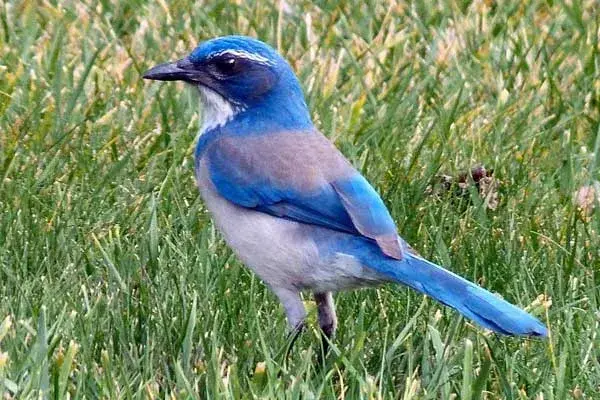
Scientific name: Sialia currucoides
Lifespan: 6-9 years
Wingspan: 14 in
Wing Color: Sky blue
Found In: Western North America
The mountain bluebird is a small migratory thrush. It is easy to recognize by a round head and a straight, thin beak.
Mountain bluebird can be found in mountainous districts of western North America.
Males have a vivid bright sky-blue plumage. The wings and tail have a bit darker blue color while the part under the tail is white.
This blue and white bird is the state bird of Idaho and Nevada.
The mountain bluebird is an omnivore that mostly feeds on spiders, grasshoppers, flies, other insects, and small fruits.
Wildlife experts estimate that there are around 4.6 million mountain bluebirds in existence today.
It is a secondary cavity nester – it builds its nest inside old woodpecker holes or naturally occurring holes in trees.
Males are the ones that look for nests while the females make the final decision. That’s because the females are the ones that build the nest.
These birds can be also seen in Northern California.
Western Bluebird
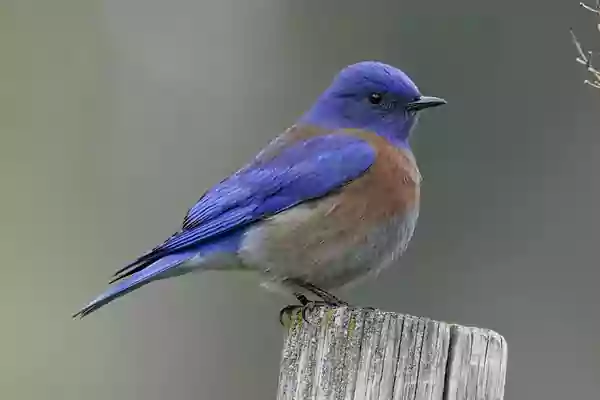
Scientific name: Sialia mexicana
Lifespan: 1-2 years
Wingspan: 10-13 in
Wing Color: Deep blue
Found In: Western North America
These small North American thrushes usually perch upright. Western bluebirds have deep blue wings, orange breasts and sides, gray bellies, and thin straight bills.
To keep competitors away and to find females in the condensed forest, male western bluebirds will make loud calls that sound like “cheer,” “chur-chur,” and “chup.”
Western bluebirds can be distinguished from other two other species of bluebirds by the throat color. Western bluebirds have blue (male) or gray (female) throats, eastern bluebirds have orange throats, while mountain bluebirds have no orange color on themselves.
Look for them in woodlands and woodland edges. Pay close attention to birds that drop suddenly to the ground after insects. Western bluebirds also feed on berries.
Western bluebirds mate for life. However, one 2003 study discovered that around 45% of western bluebird females had some chicks in the nest that are not sired by their social mates.
Blue Jay
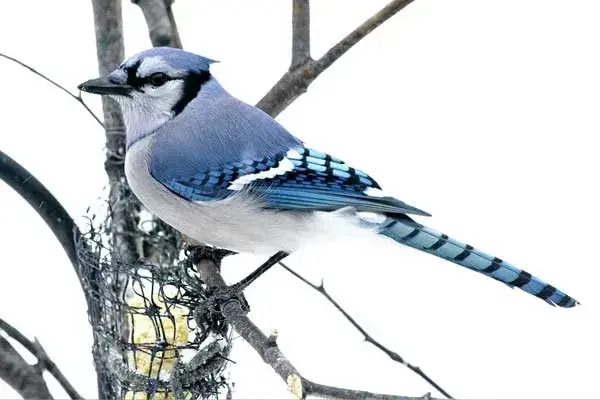
Scientific name: Cyanocitta cristata
Lifespan: 7 years
Wingspan: 13-17 in
Wing Color: Bright blue
Found In: Eastern and Central North America
The blue jay is a large songbird living in most of the eastern and central United States. It has a mix of black, blue, and white plumage above that is white or light gray underneath.
The blue jay has bright blue wings with white spots. Males and females look the same.
The blue jay is not a state bird in any US state; it is, however, the mascot of a Major League Baseball team called the Toronto Blue Jays.
They are very intelligent birds that can use tools, imitate the sounds of predators, and that love to make noise.
Blue jays mate for life and work together to build a nest for their young. When the female is sitting on the eggs, the male will feed and take care of her.
Blue jays are omnivores that mostly feed on seeds, berries, nuts, and occasionally insects.
Blue-and-white Kingfisher
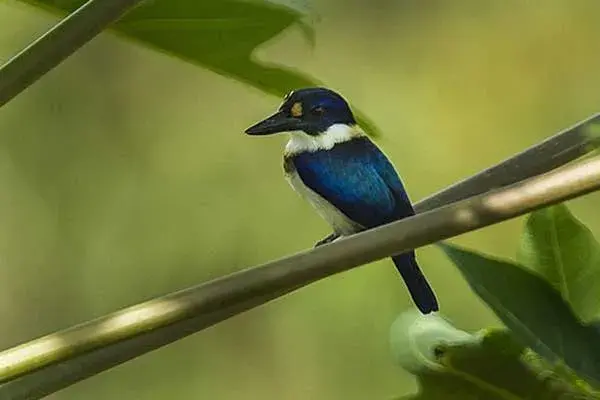
Scientific name: Todiramphus diops
Lifespan: n/a
Wingspan: n/a
Wing Color: Bright azure-blue
Found In: Asia
The blue-and-white kingfisher is a small kingfisher with bright azure-blue wings and the rest of the upperparts and a gleaming white underside.
Its natural habitat is the subtropical and tropical mangrove forests of Indonesia. It is an insectivore that loves to feed on grasshoppers.
Collared Kingfisher

Scientific name: Todiramphus chloris
Lifespan: 11 years
Wingspan: 13 in
Wing Color: Turquoise blue
Found In: Asia and Australia
The collared kingfisher is also known as white-collared kingfisher or a mangrove kingfisher.
This medium-sized kingfisher is easy to notice due to a large, black kookaburra-like beak, turquoise wings and head, a white collar, and white chest feathers. The feet are black.
Males tend to have a slightly more blue tint, while females have a slightly more greenish one.
These birds take care of their personal hygiene and will often take baths by jumping into the nearby rivers or lakes. After that, they can be seen drying and preening their feathers in bright sunlight.
Collared kingfishers are carnivores that feed on insects, crustaceans, small snakes, small birds, small fish, and even mice.
Belted Kingfisher
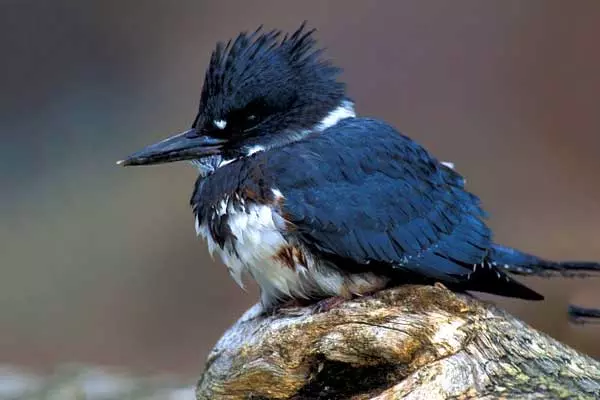
Scientific name: Megaceryle alcyon
Lifespan: 6-14 years
Wingspan: 19-23 in
Wing Color: Blue-gray
Found In: North and Central America
The belted kingfisher is a large, conspicuous water kingfisher that is native to North America.
It has a large head, a shaggy crest on the top and back of the head, and a straight, thick, pointed beak. The upper plumage is blue-gray while the underparts are white.
Belted kingfishers are very territorial and males will often chase intruders away.
If you go looking for belter kingfishers, visit streams, lakes, bays, and coasts. You will often hear them before you see them – listen for their distinct and loud rattling or chattering call.
Belted Kingfishers have two fused toes which can also help distinguish these blue-winged birds from others.
They are carnivores that dive to catch fish and crayfish with their heavy beaks. They will also eat mollusks, crustaceans, amphibians, and lizards.
Belted kingfishers can’t digest bones and will regurgitate the undigested pieces as pellets, similar to owls.
Blue-Winged Kookaburra

Scientific name: Dacelo leachii
Lifespan: 20 years
Wingspan: 25 in
Wing Color: Sky blue
Found In: Australia
This very large bird is found in tropical and subtropical open woodlands, paperbark swamps, and farmlands of northern Australia and southern New Guinea.
The blue-winged kookaburra has a white head with brown streaks, sky blue wings, and white throat and underparts.
It is also easy to identify by its big square head, a long bill, and distinctive pale eyes.
This bird is famous for its hobby – hunting snakes. The blue-winged kookaburra will grab the reptile behind the head and smash it against a branch or a rock.
They lay white and shiny eggs, and sometimes, in the first week of being born, blue-winged kookaburra chicks might aggressively kill their youngest sibling.
Blue-and-white Flycatcher
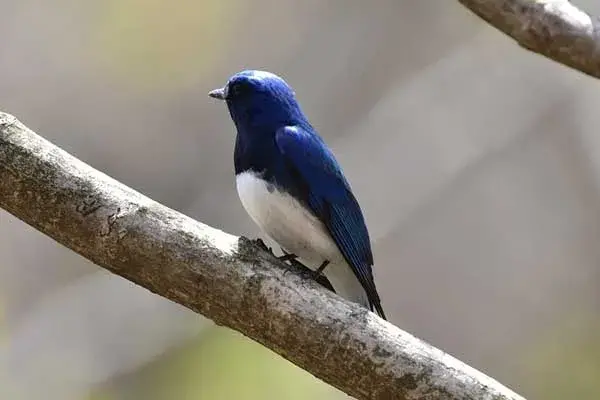
Scientific name: Cyanoptila cyanomelana
Lifespan: n/a
Wingspan: 10 in
Wing Color: Royal blue
Found In: Asia
Blue-and-white flycatchers are beautiful songbirds with royal blue wings, white bellies, and black faces, throats, and breasts.
They live in wooded areas in lowlands and submontane forests, parks, and gardens of Asia.
Blue-and-white flycatchers breed in Japan, Korea, and parts of China and Russia. They are very active and highly territorial birds.
Blue-and-white flycatchers are omnivores and feed on berries, insects, and larvae, including beetles, moths, and bees.
California Scrub-Jay
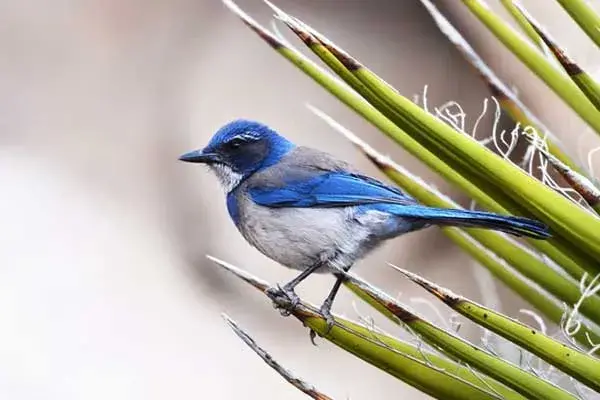
Scientific name: Aphelocoma californica
Lifespan: 9 years
Wingspan: 15 in
Wing Color: Deep azure blue
Found In: Western North America
California scrub-jays are attractive jays found in parks, neighborhoods, and riverside woods near the Pacific Coast. These medium-sized birds have deep azure wings and white and soft gray-brown underparts.
California scrub-jays can be seen around other animals, often sitting on the backs of mule deer eating ticks and other parasites.
California scrub-jays can be also seen stealing acorns from acorn woodpeckers or other jays.
When they go to hide their own acorn, California scrub-jays will check first that no other jays are watching.
They are omnivores feeding on insects, fruit, nuts, seeds, and some small animals such as lizards and nesting birds. California scrub-jays are also common birds of Southern California.
They also have a thin line above their eyes that is called a supercilium. Read more about these “eyebrows” this and many other birds have in this article.
White-breasted Nuthatch
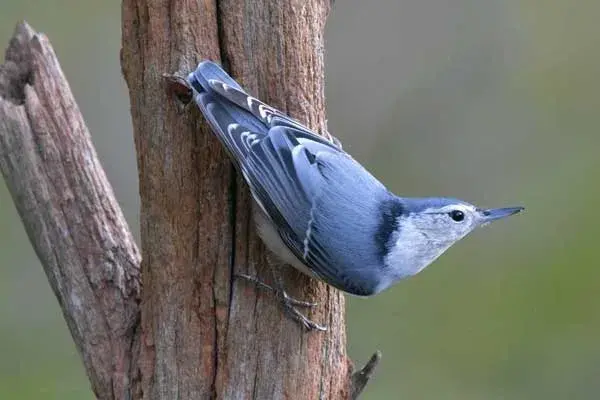
Scientific name: Sitta carolinensis
Lifespan: 2 years
Wingspan: 11 in
Wing Color: Gray-blue
Found In: North America
These are the largest nuthatches in North America.
White-breasted nuthatches are medium-sized birds with clean blue-gray and white plumage.
The male and female look very much alike, the only difference is that the female has lighter color.
These quirky and loud birds got their name from the way they crack open seeds – they will jam their seeds and nuts into tree bark, and then whack it with their beaks to open the seeds.
Common blue birds of Maryland, white-breasted nuthatches can be also found in forests and open areas in most of the United States and parts of Canada and Mexico.
They are omnivores that feed on insects and seeds.
Masked Lovebird

Scientific name: Agapornis personatus
Lifespan: 10-20 years
Wingspan: 3.5-4 in
Wing Color: Vibrant turquoise blue
Found In: Africa
Yellow-collared lovebirds, also called the masked lovebirds, are another example of conspicuous birds with blue wings.
This parrot species comes in several colors. The blue masked lovebird has a black mask, pink beak, a white collar, and deep blue wings, body, rump, and tail.
This colorful lovebird of East African savanna can be also found in woodlands, cultivated areas, and around human habitation.
Masked lovebirds mate for life and males and females look very similar.
When the breeding season comes, males become more agitated, while females build nests to rear young.
The appetite of both increases during this time; the males will bring food, feed their partner, and they might preen one another (straighten and clean feathers with their beaks).
White-throated Magpie-jay

Scientific name: Calocitta formosa
Lifespan: 15-25 years
Wingspan: 7 in
Wing Color: Bright blue
Found In: Mexico and Central America
White-throated magpie-jay is a large, noisy, and very gregarious bird. Look for it in areas of mixed grassland and woodland, around places that are under cultivation, and along forest edges.
White-throated magpie-jays are examples of blue and white birds whose breasts, bellies, and undersides are white, while the wings, mantles, and tails are bright blue.
They are omnivores that mostly feed on caterpillars and small fruits.
Being so big, handsome, active, and noisy, these magpie-Jays are sure to attract your attention and make their presence known.
Little Blue Heron
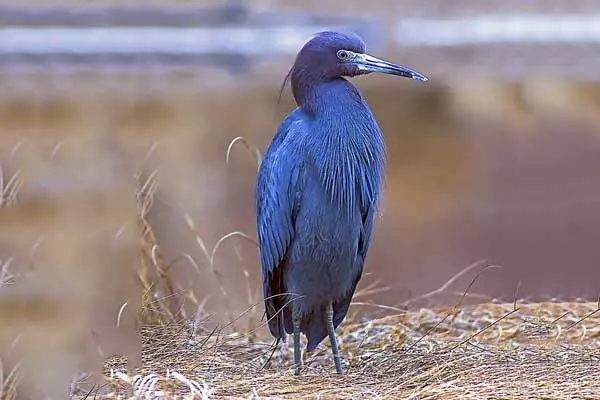
Scientific name: Egretta caerulea
Lifespan: up to 7 years
Wingspan: 39-41 in
Wing Color: Blue-purple
Found In: North, Central, and South America
This medium-sized bird is a small heron that breeds in the Gulf states of the United States.
Colored in moody blues and purples, little blue herons are found around marshes and estuaries in the Southeast.
Both sexes look similar while the juveniles are completely white in their first year.
Little blue herons have a row of “teeth” along their middle toes that they use to scratch their heads, necks, and throats.
They nest in colonies, often around other species of herons, egrets, and wading birds.
Little blue herons usually forage alone, stalking their prey methodically in shallow water. They are carnivores that feed on fish, frogs, lizards, snakes, turtles, spiders, crustaceans, small rodents, and insects.
Great Blue Heron
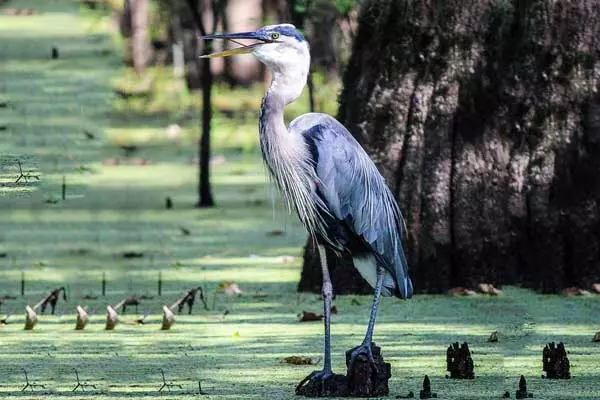
Scientific name: Ardea herodias
Lifespan: 15 years
Wingspan: 5.5-6.6 ft
Wing Color: Gray-blue
Found In: North, Central, and South America
The great blue heron is the largest of North American herons. It is easy to identify by its large yellow-orange bill, short black plumes on its head, and black and chestnut pattern on the shoulders. This large bird has subtle blue-gray wing color.
It is quite common near the shores of open water and in wetlands. During the flight, this bird will hold its neck in an S-shape with legs trailing behind.
Despite its large and stocky build, the great blue heron can reach speeds of around 30 mph.
It is monogamous only for a single season and will go through some interesting courtship rituals, locking and rubbing its bill on the feathers of the other bird before mating.
Both parents will take turns in incubating the eggs, and after hatching, the chicks can fly at only 2 months of age.
Great blue herons nest in colonies called heronries that can occasionally have more than 500 nests.
Great blue herons are carnivores that feed on fish, amphibians, reptiles, invertebrates, small mammals, and even other birds.
These birds will slowly stalk their prey in shallow waters, striking with lightning speed, catching them with their long and sharp beaks.
Great blue herons are one of our 12 biggest birds found in Ohio.
Yellow-throated Euphonia
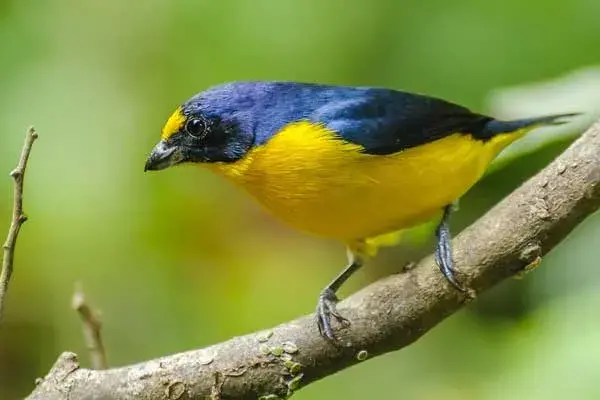
Scientific name: Euphonia hirundinacea
Lifespan: n/a
Wingspan: 2.3 in
Wing Color: Glossy blue
Found In: Mexico and Central America
Euphonia is a small songbird found in southeastern Mexico and throughout Central America.
It has a short bill, a short tail, and pointed glossy blue wings.
Males have dark blue-black heads with yellow forecrowns and bright yellow underparts.
Females are olive-green on top and whitish-gray in lower parts.
The species got its name from a Latin word that means “good sound”.
Yellow-throated Euphonia is a herbivore that feeds on fruits and berries. It has a gut that is specially adapted for eating poisonous mistletoe berries they adore.
Indian Roller

Scientific name: Coracias benghalensis
Lifespan: up to 17 years
Wingspan: 26–29 in
Wing Color: Sky blue
Found In: Asia
This brightly colored bird has various shades of blue on its wings, tail, and belly. Indian roller has adapted well to human-modified landscapes and can be often seen sitting perched on roadside trees and wires.
The species is famous for its bright sky-blue wings and the aerobatic displays males perform during the breeding season. They will make steep, undulating flights, somersaults, nose-dives, hovering, and lateral rollings – that’s how the species got the name.
Often territorial, Indian rollers will patrol their areas by flying treetop high. When they spot an intruder, they will drive it away by a fast-rolling flight. These birds are not particularly social and prefer to stay alone or in pairs.
Indian rollers are monogamous and mate for life.
Indian roller is the state bird of several Indian states, including Odisha, Karnataka, and Telangana.
Blue-winged Minla

Scientific name: Siva cyanouroptera
Lifespan: n/a
Wingspan: n/a
Wing Color: Indigo blue
Found In: Asia
Also known as the blue-winged siva, the blue-winged minla is a brightly colored bird that can be found in lowland and foothill forests of the Indian subcontinent and Southeast Asia.
Males and females look alike. They are powdery gray-blue overall, have blue highlights on their wings and tails, and soft gray-brown heads and faces.
Blue-winged minlas are gregarious birds found in flocks of 5 to 20 birds. They feed on insects, berries, and seeds.
Blue-and-yellow Macaw

Scientific name: Ara ararauna
Lifespan: 65-70 years
Wingspan: 41-45 in
Wing Color: Turquoise blue
Found In: South America
Blue-and-yellow macaws are large South American birds with blue wings. They are also known as the blue-and-gold macaws.
These enormous birds are hard to miss with their gorgeous turquoise blue bodies, green foreheads, and dark lemon-yellow chests.
Due to their striking color, ability to talk, availability in the marketplace, and close relationships with humans, blue-and-yellow macaws make a popular pet choice.
In case you decide to get one, remember that these parrots can have a long life, up to 70 years and more.
Macaws are monogamous and remain together for life. While flying, pairs will stay close together with their wings nearly touching.
They love to eat seeds in the wild – macaws will drop a lot of them on the forest ground which promotes forest growth.
Read More: 25+ examples of stunning blue and orange-colored birds
Crimson Rosella

Scientific name: Platycercus elegans
Lifespan: 25 years
Wingspan: 6.5-7.5 in
Wing Color: Rich blue
Found In: Australia
This parrot is native to eastern and southeastern Australia, where it can be found around open forests, woodlands, gardens, and parks. The crimson rosella is a medium-sized bird with rich blue wings, overall red plumage, pale gray beaks, and dark brown irises.
There are 7 subspecies of crimson rosella.
These birds can be conspicuous and noisy, especially when foraging. Crimson rosellas feed on plants, especially seeds, nuts, berries, fruits, some insects, and insect larvae.
They can’t talk like macaws, but they can mimic whistles and songs.
These parrots are also on our list of incredible blue and red birds.
Prothonotary Warbler

Scientific name: Protonotaria citrea
Lifespan: 3 years
Wingspan: 8.75 in
Wing Color: Blue-gray
Found In: Central, North, and South America
This small songbird has blue-gray wings, an olive-colored back, yellow underparts, a long pointed beak, and black legs.
Prothonotary warbler can be found in swamps of the eastern United States during summer where it breeds. This bird will migrate south and winter in the West Indies, Central America, and northern South America.
Prothonotary warbler has a nickname “golden swamp warbler” and got its name “prothonotary” from the bright yellow robes notaries attached to the Byzantine court once wore.
These birds with blue wings are also known for brood parasitism, a behavior where females lay eggs in nests of other members of their species.
Barn Swallow

Scientific name: Hirundo rustica
Lifespan: 4 years
Wingspan: 12.5-13.5 in
Wing Color: Deep blue
Found In: Europe, Asia, Africa, and the Americas
The barn swallow is the most widespread species of swallow in the world. It has a blue head and wings, rusty-orange throat and forehead, and a pale orange chest and underside.
Barn swallows are distinguished for their long, slender, and deeply forked tails. Males and females look similar – the female’s tail is a little less forked.
According to legend, the Barn Swallow got its forked tail because it stole fire from the gods and brought it to people. This made the gods angry so they threw a firebrand at the swallow, burning its middle tail feathers.
The barn swallow is one of the largest swallow species found in Maryland and Pennsylvania.
In early fall, this long-distance migratory bird flies from North American breeding grounds to winter in Central and South America.
Barn swallows are insectivores that catch and eat insects in the air as they fly.
Read More: 25+ examples of Central Texas birds
In Summary
This concludes our list of birds with blue wings.
There are plenty of examples of such.
Some are small, like the eastern and western bluebird, and yellow-throated Euphonia, while others are rather big, like the blue jay, blue-and-yellow macaw, and others.
Either way, next time you see any of these birds in person, you should be able to recognize them with ease!
And if you enjoyed our article, here are our other popular reads on birds: 18+ examples of white birds living in Hawaii, 25+ common birds of Northeast Ohio, and 2 species of loons found in Michigan.